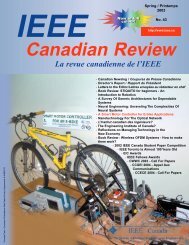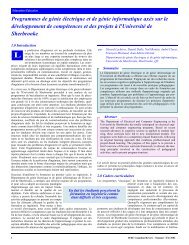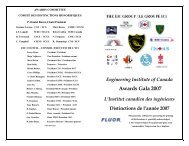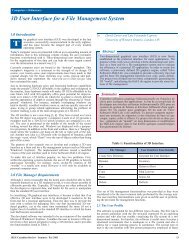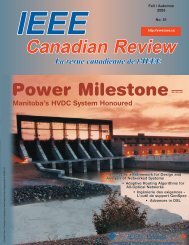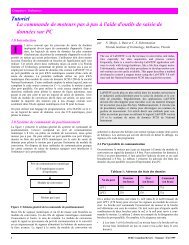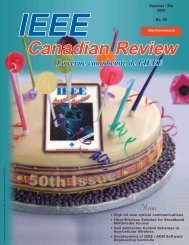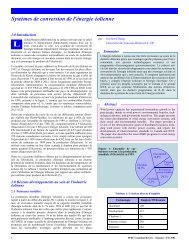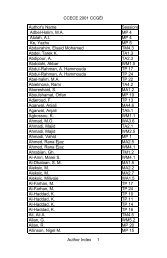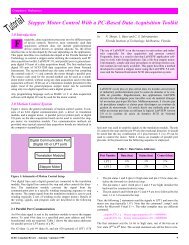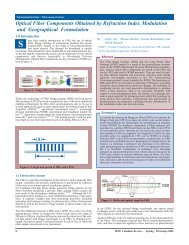Download Presentation [950KB PDF] - IEEE
Download Presentation [950KB PDF] - IEEE
Download Presentation [950KB PDF] - IEEE
You also want an ePaper? Increase the reach of your titles
YUMPU automatically turns print PDFs into web optimized ePapers that Google loves.
1 Mutual Coupling Modeling in Transmission Lines directly in the Phase Domain Rodrigo C. Silva (Unesp – Univ. Estadual Paulista) Eduardo C. M. Costa (Unicamp – University of Campinas) Sérgio Kurokawa (Unesp – Univ. Estadual Paulista) José Pissolato (Unicamp – University of Campinas) <strong>IEEE</strong> 2011 Electrical Power and Energy Conference
2 ObjecLves: • Mutual coupling between phases using only lumped elements (without the complex use of electromagneLc field theory). • Simplified digital model based on line parameters (without the explicit use of modal transformaLons between the phase and mode domains). • Easy interacLon between the line model with Lme-‐variable and non-‐linear components (capacitor bank, corona, variable load profile, etc). • Simplified applicaLon for didacLc or research purposes. <strong>IEEE</strong> 2011 Electrical Power and Energy Conference
3 TheoreLcal Features IinZIoutVinYYVout<strong>IEEE</strong> 2011 Electrical Power and Energy Conference
4 TheoreLcal Features i1z1i2z2...inznVinyyy y yv1 v2 vn...<strong>IEEE</strong> 2011 Electrical Power and Energy Conference
5 Main Advantages: • SimulaLons direct in the Lme domain, without the use of inverse transforms and convoluLons. • Possibility of inserLon and modeling of other Lme-‐variable power devices directly in the Lme domain (loads, protecLon devices, surge arresters, capacitors, etc). • Detailed profile of voltages and currents at any point of the line. • The line lumped parameters are set as a funcLon of the electromagneLc transient considered as the input signal. This way good results can be obtained without the explicit representaLon of frequency-‐variable parameters. <strong>IEEE</strong> 2011 Electrical Power and Energy Conference
6 Three-‐Phase RepresentaLon: Z 11Bz 22y 12y 13y 23• A schemaLc representaLon of a three-‐phase system with its self and mutual parameters is given in the illustraLon. Ay 12y 23z 33y 30• The line parameters are expressed as follows: y 13y 10 y 10y 20y 20y 30<strong>IEEE</strong> 2011 Electrical Power and Energy Conference
7 Three-‐Phase RepresentaLon: • The modeling of the mutual parameters and coupling between phases is not a trivial task. This way modal analysis techniques are widely applied to model three-‐phase systems. Where [T V ] a n d [ T I ] a r e m o d a l transformaLon matrices obtained from the eigenvectors and eigenvalues of the products [Z][Y] and [Y][Z] respecLvely. <strong>IEEE</strong> 2011 Electrical Power and Energy Conference
8 ConvenLonal Algorithm: Line decoupling into their exact propagaLon modes. Modeling of each exact mode by lumped elements. SimulaLon of the currents and voltages in the Modal domain. Conversion of modal values to the phase domain. <strong>IEEE</strong> 2011 Electrical Power and Energy Conference
9 New Algorithm: Line decoupling into their exact propagaLon modes. Development direct inthe phase domain.Modeling of each exact mode by lumped elements. SimulaLon of the currents and voltages in the Modal domain. Proposal of a line model direct in the phase and Lme domains without the successive modal transformaLons. Conversion of modal values to the phase domain. <strong>IEEE</strong> 2011 Electrical Power and Energy Conference
10 Proposal of a Three-‐Phase Model in the Phase and Time Domains: 1) The modal parameters Rm, Lm, Cm, Gm and the modal currents and voltages are expressed as func>ons of the phase parameters: 2) The parameters, currents and voltages in the phase domain are subs>tuted in the differen>al equa>ons of the line: <strong>IEEE</strong> 2011 Electrical Power and Energy Conference
11 Proposal of a Three-‐Phase Model in the Phase and Time Domains: 3) The differen>al equa>ons are represented in the state space: -‐ n is the number of pi elements. -‐ A, B and C are the phases. -‐ The elements of the state matrices [A] and [B] are funcLon of the line parameters. <strong>IEEE</strong> 2011 Electrical Power and Energy Conference
12 Proposal of a Three-‐Phase Model in the Phase and Time Domains: -‐ From the same way, other elements of matrices [A] and [B] are determined based on the self and mutual parameters of the line. -‐ The modal transforma>ons are intrinsic considered in the space-‐state model. <strong>IEEE</strong> 2011 Electrical Power and Energy Conference
13 SimulaLons: -‐ A convenLonal 440-‐kV transmission line is considered and a simple simulaLon test is performed based on the following system configuraLons: 20-‐kV Step SignalThree-‐phase high-impedance loadV S1Phase 1V R1I R1Phase 2V R2I R2Phase 3V R3I R3Three-‐phase lineground<strong>IEEE</strong> 2011 Electrical Power and Energy Conference
14 SimulaLons: -‐ ATP/EMTP cascade of pi circuits: red-‐dash curve -‐ Proposed Model: blue curve <strong>IEEE</strong> 2011 Electrical Power and Energy Conference
15 SimulaLons: -‐ ATP/EMTP cascade of pi circuits: red-‐dash curve -‐ Proposed Model: blue curve <strong>IEEE</strong> 2011 Electrical Power and Energy Conference
16 Conclusions: • Results show a good accuracy when compared with those obtained from the cascade of pi circuits available in the ATP/EMTP. • The three-‐phase model is enLre developed in the phase domain, without the explicit use of modal transformaLon matrices. • Development of a three-‐phase representaLon and coupling between phases by a state space model, which represents the original proposal of the paper. <strong>IEEE</strong> 2011 Electrical Power and Energy Conference
17 Financial Support: <strong>IEEE</strong> 2011 Electrical Power and Energy Conference


![Download Presentation [950KB PDF] - IEEE](https://img.yumpu.com/50598566/1/500x640/download-presentation-950kb-pdf-ieee.jpg)
![Download Presentation [1.9MB PDF] - IEEE](https://img.yumpu.com/51364167/1/190x146/download-presentation-19mb-pdf-ieee.jpg?quality=85)

